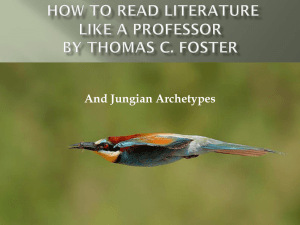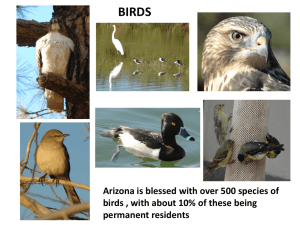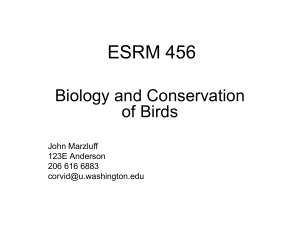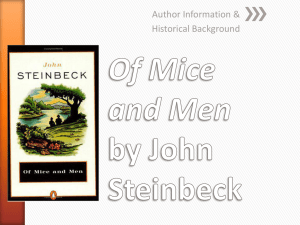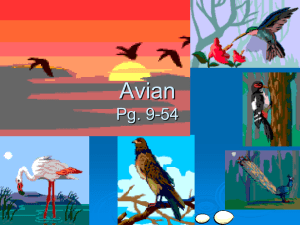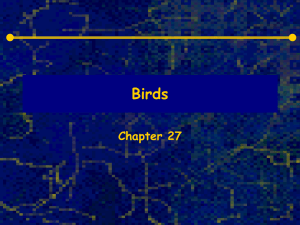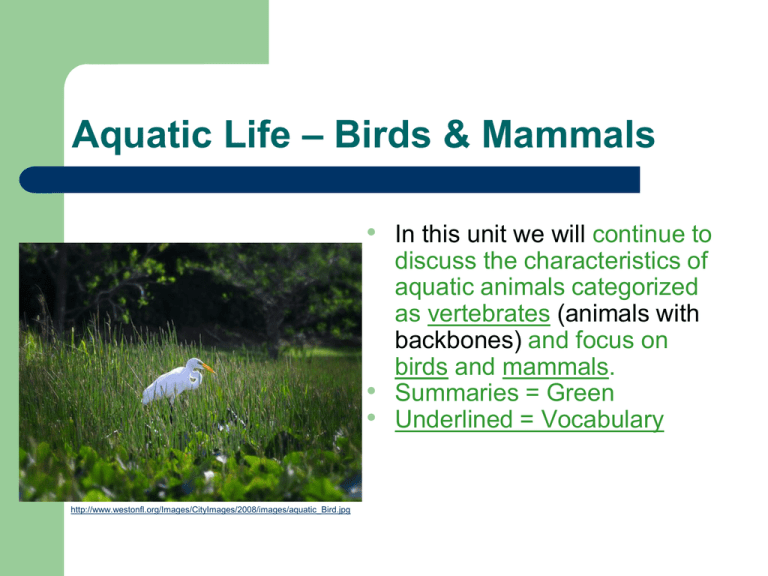
Aquatic Life – Birds & Mammals
• In this unit we will continue to
discuss the characteristics of
aquatic animals categorized
as vertebrates (animals with
backbones) and focus on
birds and mammals.
• Summaries = Green
• Underlined = Vocabulary
http://www.westonfl.org/Images/CityImages/2008/images/aquatic_Bird.jpg
Review of Taxonomy
• Kingdom Animalia
• Phylum Chordata
• Subphylum Vertebrata (animals that have backbones)
• Superclass Tetropoda (organisms with four limbs)
• Class Aves (Birds)
• Class Mammalia (Mammals)
What is a Bird?
• Birds, or Class Aves, are the
•
•
only group of vertebrates, not
including bats, with forelimbs
modified into wings for flight.
Birds, along with mammals, are
endotherms and maintain an
internal body temperature.
Ornithology is the study of
birds.
http://www.birminghamzoo.com/image_g
allery/hi_res/peacock.jpg
Bird - Origins
• Birds evolved approximately
•
•
225 million years ago from
feathered reptiles.
Earliest known fossil is
Archaeopteryx
• considered first “bird”
because of presence of
feathers; first fossil was
found in 1861
• still had reptilian features
such as clawed forelimbs,
teeth and a long tail
Video
http://www.damisela.com/zoo/photo/cq4/archaeopt
eryx.jpg
Bird - Respiration
• Avian respiratory systems
contain extra air sacs, that
are connected to lungs,
extend throughout their
bodies, allowing birds to
take in large amounts of
air.
• The ability to maintain extra
oxygen in the system
allows birds to supply their
cells with more oxygen
during flight and
submersion.
Ron Freethy
Video
At Bodega Bay, California, wild pelicans
dive into the sea to catch fish. This
one came back to the surface with at
least three fish in his mouth. The
pelican was waving his beak to
swallow the fish.
Photograph by Roger Lee
Bird - Circulation
• The avian circulatory system contains a 4-chambered
•
•
heart and a double loop design.
Oxygen-rich and oxygen-poor blood are separated from
each other.
Birds have a rapid heartbeat and high blood pressure to
make circulation very efficient.
http://www.paulnoll.com/Ore
gon/Birds/AvianCirculatory.jpg
Bird - Reproduction
• Reproductive organs in birds are reduced in size except
during nesting season.
• Males have internal penis
• Females only have one ovary instead of two.
• There are oviparous and lay external, hard shelled eggs.
• Internal fertilization, which occurs
through cloaca.
• Bird eggs are similar to reptile
eggs but have a larger yolk and
they must be incubated and kept a
constant temperature.
• Birds provide care for their young
after they hatch.
http://www.uscg.mil/d5/msafety/rrt/images/eggs_noaa.jpg
Video
“Huddling together in
subzero temperatures,
these playful emperor
penguin chicks face a
fight for survival in their
Antarctic home with
temperatures plunging to
-76F (-60C) and winds
over 100mph.”
The Telegraph
Bird – Digestion & Excretion
• Birds swallow un-chewed food with a toothless beak and
store it in the crop were it is later digested or regurgitated to
feed their young.
• From crop, food moves to gizzard (muscular organ that
usually contains small stones and breaks down food with help
of digestive enzymes).
• Intestines absorb nutrients from
food.
• Do not have a urinary bladder
but excrete automatically.
• Some birds have salt-secreting
gland to remove excess salt
from bodies.
http://www.infovisual.info/02/img_en/055%20Internal%20a
natomy%20of%20a%20bird.jpg
Class Aves
• Class Aves is classified into orders based on
body structure and color, beak structure, foot
structure, behavior, song, nest structure and
placement or distinctive egg color and size.
• Wading Birds (Waders) – Associated with coastal
•
•
areas and often seek sea life for food
Diving Birds – Birds that plunge under water to dive
for food
Penguins – aquatic, flightless birds, live almost
exclusively in the southern hemisphere
Migration
• Birds often travel long
distances to reach warmer
locations in winter (migration)
to escape poor weather and
seek a better food supply.
• They navigate in several ways
using landmarks (rivers,
mountains, coastlines), the
Earth’s magnetic field, and the
position of stars.
• Flocks of birds, or following
neighbors, often fly together.
http://www.teara.govt.nz/NR/rdonlyres/47D2A3EE-0C5B-49CD-A86C5B2689C86931/122295/hero7208.jpg
Bird – Adaptations for Flight
• Birds have feathers adapted for
flight.
• Feathers are modified from
reptilian scales (longer and
fringed), made of keratin to
insulate and protect the bird
from weather.
• Feathers also provide smooth,
low-friction surface.
• Oil from a gland at base of tail is
used to smooth and waterproof
feathers.
http://sophia.smith.edu/~jmoulton/Hawaii/images/animal%20parrot.jpg
Adaptations for Flight Cont.
• Bird skeletons consist of hollow
•
bones (air reduces overall
weight) and is very strong due to
a network of cross braces within
bone.
Some bones are fused which
reduces need for heavy
ligaments.
CARLYN IVERSON / SCIENCE PHOTO LIBRARY
Adaptations for Flight Cont.
• The bird’s pectoral muscle (chest) is 25% of total weight
and needed to flap wings during flight.
• Birds have a reduced body weight and are more compact
to allow for flight.
Peter Theimann
What is a Mammal?
• A mammal is described as an
http://www.ifwp.net/competition/compet_2006/45
0/ifwp2006_mammals3.jpg
organism that:
• has hair or fur (made of keratin)
• nourishes young with milk
• and is endothermic and
maintains an internal body
temperature.
• Mammals also have layers of fat
that help them to keep warm and
can have sweat glands to cool off.
• Mammals can be either aquatic or
terrestrial for both; their forelimbs
are adapted to a specific way of life
(climbers, runners, diggers, flyers,
swimmers).
Mammal - Respiration & Circulation
• All mammals, whether
aquatic or terrestrial,
breathe with lungs.
• They have efficient lungs,
the sperm whale can stay
submerged for up to an
hour!
• Blowhole = fully aquatic
mammals have an
additional hole to breath in
and out
• Mammals have a doubleloop circulatory system
with a 4-chambered heart.
http://training.seer.cancer.go
v/module_anatomy/images/ill
u_heart.jpg
Video
http://www.well.com/user/pk/waterfront/photo-of-the-week/Blowhole.jpg
http://chrisjury.files.wordpress.com/2009
/11/mom-baby-seal.jpg
Mammal - Reproduction
• Mammals are viviparous (live birth) and nutrients pass to
the embryo from the mother through a placenta.
• Females have mammary glands to produce milk for their
young.
Orders of Mammals
• Placental
Mammals
complete
embryonic
development in
mother’s uterus.
http://em
bryology.
med.unsw
.edu.au/N
otes/imag
es/placent
a/plMembr
aneW600.j
pg
Mammal – Feeding & Excretion
• The mammalian diet varies and,
therefore, specialized teeth according
to the diet.
• herbivores – eat plants
• carnivores – eat meat
• omnivores – eat both plants and
meat
• blood-eaters – example would be
vampire bat
• filter feeders – example is the blue
whale with modified teeth called
baleen for plankton
http://maxshouse.com/Teeth.jpg
“Made of keratin, like
human fingernails
and hair, baleen
plates on either
side of a whale’s
enormous mouth
act as a huge
strainer.”
From National
Geographic
http://schools.look4.net.nz/science/biology/marine/fish/fish_files/baleen-whales.jpg
Mammal – Excretion
• Mammals have a complex digestive system using kidneys and
intestines to excrete wastes.
http://marinemammalconservancy.org/wp-content/uploads/2010/03/anatomy.jpg
Mammal – Aquatic Groups
• Order Monotremata
• Monotremes are different in that they lay eggs
http://www.sanchona.com/platypus
%20b.gif
•
(oviparous) but produce milk excreted from pores on the
mother’s abdomen that the young lick milk.
EX semi-aquatic duck-billed platypus
Cont.
• Carnivora – dogs, cats,
bears
• Cetaceans – whales,
dolphins, porpoises with
thick layers of subcutaneous fat; are
carnivores; cannot
survive on land
• Sirenians – manatee,
sea cow (aquatic
herbivores)
Sometimes called a sea cow, the placid
manatee lives in shallow coastal waters and
rivers. Photograph by Brian J. Skerry
Cont.
• Pinnipedia – sea lions and walruses (Latin for pinna,
http://upload.wikimedia.org/wikipedia/commons/2/27/Leopard_seal_ba
sking_on_Iceberg.jpg
“wing or fin” and ped-, “foot”)

